Trees can be used to enhance privacy in your backyard. Privacy trees form dense hedges that bar anyone from spying on you while enjoying with friends or family on your patio, deck or porch.
Further the natural privacy screen will provide shade, windbreak, noise barrier, fresh breeze and a spectacular feature in your backyard. However, not every tree can serve this purpose, in this guide we have the best fast growing trees for backyard privacy.
10 Fast Growing Trees for Privacy
Growing privacy trees is one of the cheap ways to block neighbor’s view in your backyard. The following are best trees for privacy in the yard including how to plant and care for them.
1. Bamboo
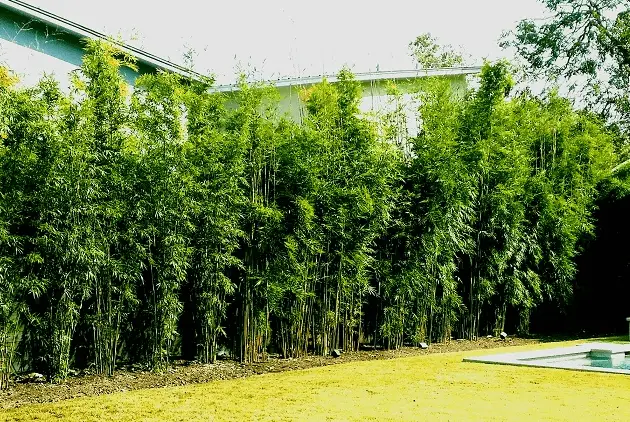
Bamboo is one of the fastest growing plant and thus ideal for a privacy screen in your backyard. However, choosing the right species of bamboo for blocking neighbors view is the first step, this is to avoid aggressive variety that will put you into conflict with your neighbor or municipality.
This evergreen perennial comes into two classes namely, running and clumping bamboo. Running bamboo is an invasive and tend to spread rapidly. It is difficult to control and thus not suitable for a natural privacy screen.
Clumping bamboo on the other hand is easily contained and sculpted into the desired size and shape. The shoots does not go far away from the parent plant. Clumping bamboo is thus the best type for growing privacy fences and screens. Species such as Seabreeze bamboo, Bambusa nana, Blue Chungii, Oldhamii and Gracilis Graceful bamboo are great choices for creating privacy screen or hedge.
Planting and Care
With USDA hardiness zone 5-9, the best time to plant bamboo is either in spring or early autumn. Transplanting is the fastest way of growing bamboo. The already established plants will take the shortest time to form a live fence.
Well drained fertile soil, watering in plenty and application of a slow release fertilizer will make your bamboo to thrive. Trim the tops at a desired height to prevent it from growing taller. Bamboo is a hardy plant you will hardly deal with serious pests and diseases.
2. Arborvitae
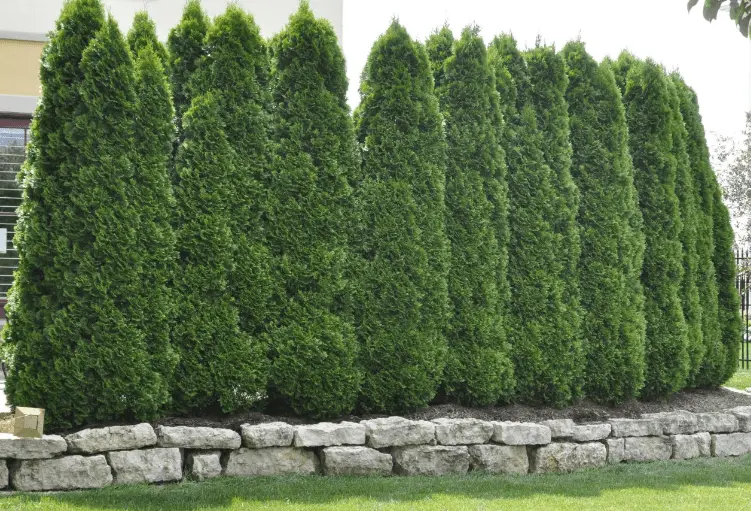
If you’re looking for fast-growing and evergreen trees for a privacy screen or hedge, arborvitaes are the best. These easy-care plants just take a year or two to form an attractive lush, dense foliage that no eyesight can cross.
Arborvitae also known as Thuja come in various species, American arborvitae and Giant arborvitae being the most common. The size of a mature Arborvitae depends on an individual species. While large trees can exceed heights of 70 feet and widths of 25 feet, there are also low-growing species under 3 feet tall.
Planting and Care
Although most zones in the United States provides ideal conditions for growing arborvitae, they are hardy to USDA Zone 3. Early spring is the best time to plant potted nursery arborvitae plants. This will provide enough time for the roots to establish before winter sets in.
The soil should be well drained and in an area that receive full to partial sunlight. When planting a hedge or privacy screen, space the plants in 3 to 4 feet.
Arborvitae hardly need any care as long as the soil is fertile and plenty watering is done. The plants will grow into mounded, conical or pyramidal shapes. They will retain their natural shapes as they mature but a light pruning in early spring keep them tidy and encourage thicker growth.
Arborvitae trees are likely to be affected by pests and diseases. Spider mites, aphids, bagworms and others can cause the leaves to gray and brown making the plant susceptible to twig blight.
3. Holly
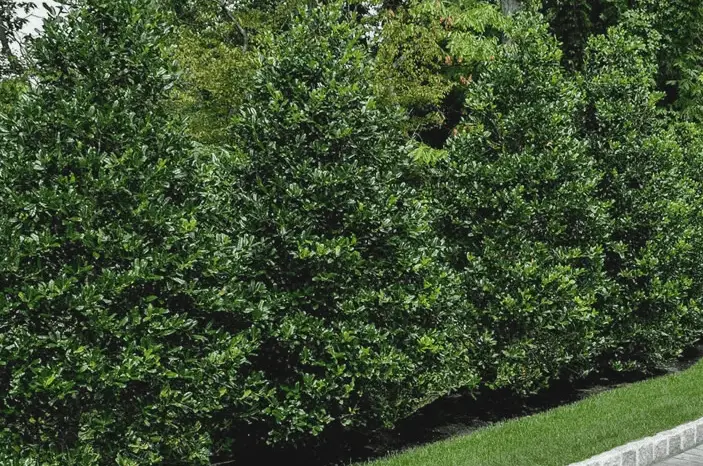
Holly is a type of evergreen trees and shrubs that come in varieties of species, sizes and shapes. Tall trees may exceed a height of 70 feet and dwarf shrubs can be as short as 6 inches tall. Shapes vary from rounded, columnar to pyramidal.
Holly trees such as American holly, Nellie Stevens and English holly are commonly used for creating privacy screen to block street traffic and neighbors. These attractive trees also adds visual appeal to a landscape and most families and organizations use them for Christmas decorations both indoors and outdoors.
Planting and Care
Holly tree is hardy in USDA plant hardiness zones 5 to 9. Spring through summer is the ideal time to plant potted nursery holy plants. The area should be located in full to partial sun. The soil should be well-drained with a pH below 6.5. After planting, water the plants consistently until they establish.
The trees may not require fertilizer, especially if they’re planted in a fertilized or rich soil, but if you see it looking weak, apply an acidifying fertilizer in spring, according to package directions. American holly trees can tolerate mild drought but a 2- to 4-inch layer of mulch around the holly hedge after planting can conserve moisture and regulate temperature.
4. Boxwood
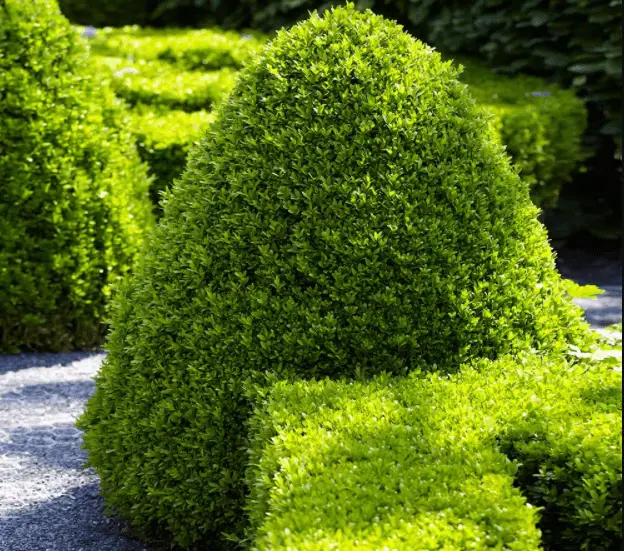
This is an evergreen versatile shrub that provides a year round structure and color to the garden and landscapes. It a popular plant in American homes due to its tolerance for both summer and winter conditions. Boxwood comes in varieties that fall under American boxwoods, English boxwoods and Japanese boxwoods.
Size varies per species but typically ranges from 1 to 20 feet tall and 2 to 8 feet wide. Mainly grown for their foliage, their winter bloom is insignificantly small. Wintergreen and green beauty are the ideal verities for privacy hedges. They are fast growing and will fill in quickly. For groundcover, topiaries and rock gardens, Morris Dwarf and Morris Midget works well without much maintenance requirements.
Planting and care
Most Boxwood plants are hardy in USDA plant hardiness zones 5 to 9 with few varieties hardy to Zone 4. The shrubs thieve in partial shade but can tolerate full sun but it entirely depends on the specific variety. When exposed to too much sun and dry winter wind, most varieties will suffer from bronzing- causing the foliage to turn yellow-orange or reddish-brown.
Late winter to early spring is the best time for planting boxwood. The plants tolerate a variety of soils with good drainage. Boxwoods will not do well in wet areas and low-lying portions of a landscape. It is thus important you plant them on berms. Due to their shallow root system, planting at a proper depth and adding a 2-3 inches layer of much will prevent the plant from drying out.
Newly planted boxwood should be watered regularly. Once established, weekly watering during hot dry weather will help in sustaining the soil moisture level. Pruning boxwood in late spring or summer encourages new growth and keeping it compact. Do not overdo or trim in fall and winter.
Since boxwood plants are sensitive to winter winds, providing some extra protecting can help in preventing bronzing. You may use decorative protection wraps or a windbreak. Boxwood blight, leaf spots, powdery mildew and pests are concerns when you have boxwood plants.
CAUTION! Boxwood contain alkaloid a toxic substance harmful to pets, cattle and human. The plant can also produce a pungent scent which can also be helpful in deterring deer from your garden.
5. Hicks Yew
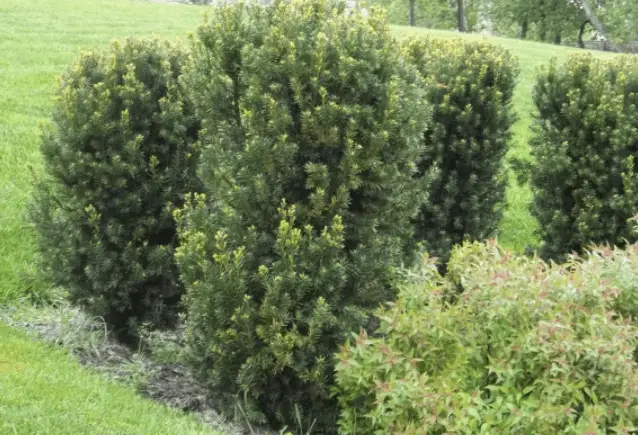
Hicks yew is an evergreen attractive shrub with a dense, shiny foliage. This easy to care for plant can tolerate a range of growing condition. This makes them popular and excellent choice for landscaping and creation of privacy hedges. Hicks yews comes in different verities with height ranging from 4 to 20 feet tall. The conifers produce cones and colorful red berries.
Growing and Care
Hicks yews grows well in U.S. Department of Agriculture plant hardiness zones 4 to 7. The plants can tolerate a variety of well-drained soils but thrives in rich loamy soil with a neutral soil pH. Poorly drained soil can result in root rot.
Yews can be grown in full sun or partial shade. In full shade, the plants will grow slower and thin. The soil has to have a moderate amount of moisture. Watering after planting is important then regularly in prolonged drought periods.
To encourage growth, fertilize in the early spring, beginning a year after planting. Mulching or adding compost one foot away from the trunk through the drip line is a great option for enriching the soil and also conserving soil moisture.
A good pruning during early spring promotes lush growth and help in trimming the plant to a desired shape. This is also be best time to remove any dead or damaged branches. Generally, yews doesn’t require much care or maintenance.
6. Cypress
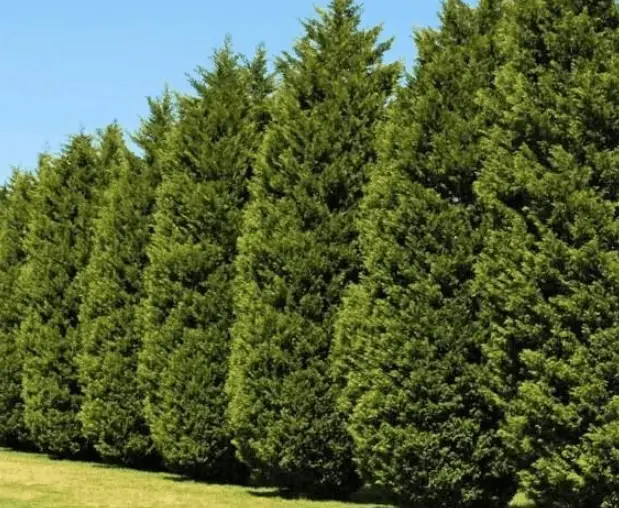
Cypress are fast growing trees ornamental trees and shrubs best for privacy hedges. Cypress has thick foliage and feathery appearance defined by needle like leaves that fall off or change color in fall. There are also evergreen varieties that grace gardens year round.
Growing and Care
Cypress is hardy, low maintenance, and easy to grow plants. The trees are hardy is USDA zones 5 through 10. Cypress grows best in full sun to partial shade. Soil requirements vary, depending on the variety. Some varieties thrive in wet soil, while others like dry rocky soils.
To plant cypress dig a hole about twice the size of the root ball. Mix in some rich compost manure. Remove the rooted plant from the container or bag and set it into the hole, and spread some top soil to cover root zone. Water thoroughly, 2 -3 times a week for a couple weeks until the plant establishes.
Mulch around plants, to help keep enriching the soil, retaining moisture and controlling down weeds. Addition of fertilizer is not necessary, except in the poorest of soils. You will need to train and trim your cypress to get a thick lush hedge.
Cypress are long-lived trees that doesn’t need much plant care. Although they rarely suffer from diseases, bagworms and mites may occasionally attack cypress trees
7. Spruce
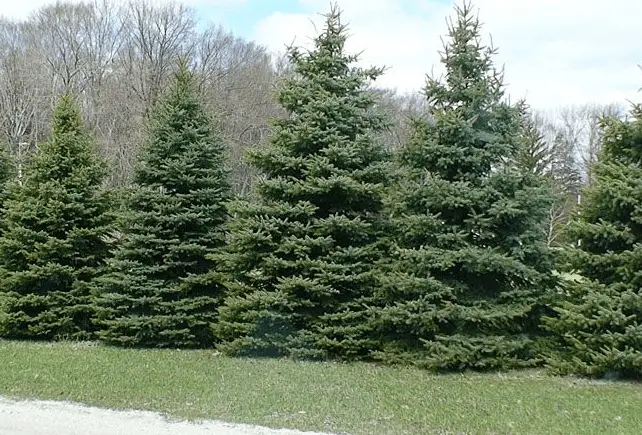
These are evergreen coniferous trees native to the temperate and cold regions of the Northern Hemisphere. Spruce come in varieties of species including white spruce, black spruce and Colorado blue spruce among others. The pyramidal shape, foliage color and nice scent makes spruce a great choice for landscape uses including Christmas tree, privacy screens and windbreaks.
Planting and Care
Spruce trees are hardy in USDA plant hardiness zones 2 to 7. They adapt to variety of soils as long as they are well drained. These drought-tolerant trees thrive in full sunlight. In the first season of planting, water adequately to keep the soil moist and later watering can only be done during dry spells. Applying 2 or 3 inches of garden mulch around the plants will help in retaining soil moisture.
Planting seed is a common method for propagation but for a quick establishment, buy spruce trees in containers and plant in spacious holes added with some compost. The trees will not need frequent fertilization but a slow release granulated fertilizer over the soil in the root zone during spring can give them a nutrition boost.
There is no need of pruning spruce trees unless you want to promote a dense foliage. Aphids are the major problem that may affect spruce trees which usually cause yellowish blotches on their need-like leaves.
8. Juniper
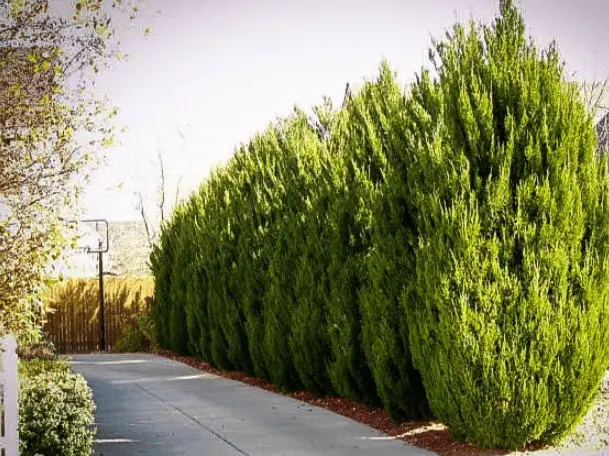
Juniper comes in varieties that include trees, shrubs and groundcovers. The evergreen plant has prickly needle-like leaves that mature into flattened scale-like appearance. The soft foliage features varying shades of green, blue, silver, and gold, with some species acquiring bronze or other tones in winter.
Juniper grows 2 to more than 40 feet tall and 1 to 25 feet wide depending on variety. This plant has many uses in landscaping, including as privacy screens, hedges, ground cover, shade trees, and more. They also attract birds and wildlife thus a source for bird view.
Planting and Care
Early spring is the best time to grow your juniper plant. The location should be sunny with well-draining soil. Prepare a spacious hole, set in the plant and cover the hole with loose soil leaving the top of root slightly outside. Water regularly until the plant gets established. Overwatering can cause the roots to rot.
While junipers need little to no pruning, in the early spring you can trim slightly to enhance the shape. Severe pruning of overgrown tree will lead to permanent bare gaps in the foliage. There is no need to fertilize juniper but a slow release in early spring can promote lush growth.
Although juniper requires little care and maintenance when planted in optimal conditions, there are dangers of diseases associated with overly wet soil, poor spacing and too much shade. Insects including spider mites, bagworm, juniper twig girdler, scale, juniper needle miner, sawfly, and bark beetle are also common problems.
9. Serviceberry
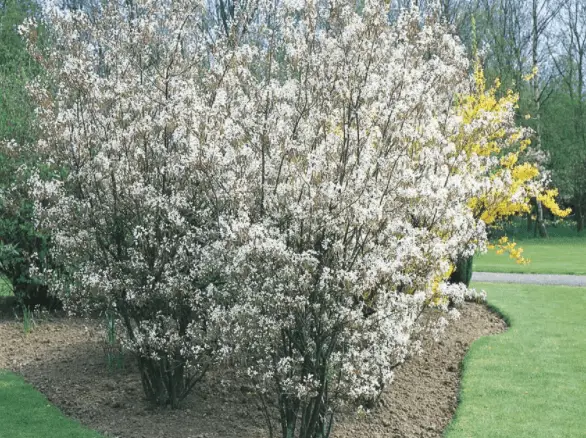
These are beautiful trees that also produce edible fruits. Serviceberry offers a spectacular snowy white blooms in the spring and dense fall foliage. On maturity, they attain between 6 to 20 feet in height with canopy reaching up to 10 feet across. Serviceberry has sweet scent and the plant can be used as privacy screen in backyard.
Planting and care
Serviceberries grows across U.S. Department of Agriculture plant hardiness zones 2 through 8. The bushes should be planted in well-drained soil with pH range between 5.5 and 7.5. The plant should receive at least six hours of daily sun although they can still do well in partial sun.
Plant serviceberries about 9feet apart for fruits and as a hedgerow. Irrigate the plants until they establish. In dry conditions, also water them to keep soil moist. Place a 2-inch layer of mulch around the plant a feet away from trunk to help with moisture retention, discourage weeds and to add a decorative effect
Supply serviceberries with organic fertilizer in spring and fall as directed by the manufacturers. Mature trees don’t really need fertilizer. Prune the trees in late winter or early spring. Inspect the tree and remove deadwood, diseased wood and broken branches.
10. Chaste

This is a deciduous shrub that blooms from late spring, through summer to early fall with spikes of pink, lilac and white flowers. It grows up to 20 feet tall and 5 to 8 feet wide. It is one of the best trees you can use for backyard privacy screen.
Growing and care
Chaste grows well in hardy zones 6 to 9. It requires full sun to partial shade. To grow this shrub, soil must be well-drained. Watering is only essential after planting, thereafter there is no need as the plant is drought tolerant. Further this plant does not like moisture around the roots or rich soil which therefore no need for a mulch.
Pruning in winter will help in controlling this aggressive shrub and keeping it in good shape. Problems with chaste plants are root rots, nematodes, and leaf spots although not common.